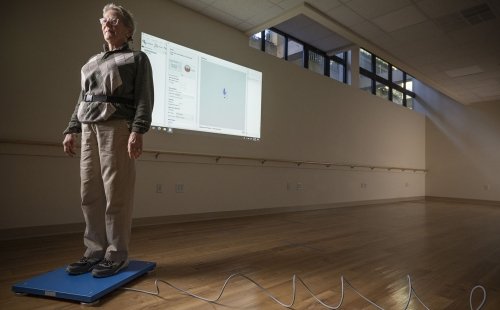
Physical Health and Function
Through the Marcus Institute’s research we are learning how older adults can maintain independence and quality of life.
Research About Maintaining Physical Function as We Age
Mobility is the most common disability among older Americans. More than 40 percent of older adults ages 65-79 have at least one disability in either self-care, household activity, or mobility. For those 80 years and older, this share rises to more than 70 percent.
Moreover, 10 percent of older adults in the community and up to 50 percent in nursing homes have frailty, which is a state of increased vulnerability resulting from a decline in function across multiple systems of the body. The "oldest old" are especially at risk of developing the condition.
Maintaining physical function as we age is key to living independently and continuing the lifestyle and activities that bring us meaning and joy.
The Marcus Institute's research into the physical health and function of older adults focuses in six main areas:
- Mobility
- Nutrition
- Arthritis
- Frailty
- Osteoporosis
- Falls
Marcus Institute Research About Maintaining Mobility and Preventing Frailty in Older Adults
The Marcus Institute's research programs are dedicated to uncovering how physical health and function of older adults impacts their quality of life, and discovering interventions to maintain physical health and function.
Marcus Institute researchers are:
- Investigating innovative methods to measure and apply frailty in various clinical and research settings
- Examining the prevalence, causes, and prevention of frailty
- Studying the prevention and treatment of musculoskeletal disorders including fractures, osteoporosis, osteoarthritis, sarcopenia and hyperkyphosis
- Examining the role of diet and nutrition in bone and muscle health and frailty
- Conducting ground-breaking research in the use of non-invasive brain stimulation to improve mobility and balance and reduce falls among older adults
Explore this section to learn more about current research projects underway to study and improve physical health and function in older adults.
Find current research projects
Showing 39 Results
The Gut Microbiome and Bone Microarchitecture
This research aims to test the central hypothesis that the gut microbiome is associated with BMD, microarchitecture, and strength.
Principal Investigator
Understanding and Modulating Cortical Dynamics of Dual-task Standing in Older Adults with Mild Cognitive Impairment
This research aims to determine whether non-invasive brain stimulation improves balance and walking. Biological aging and cognitive decline interact to disrupt the complex control of balance and mobility. Mild Cognitive Impairment (MCI) represents a common prodromal phase of dementia. As compared to older adults who are cognitively-intact, those with MCI tend to exhibit poor “dual-task” standing balance performance; that is, the ability to maintain balance when standing and simultaneously performing an unrelated cognitive task. Moreover, those older adults who have worse dual-task standing balance are more likely to suffer falls and develop dementia. By studying the cortical control of balance in older adults with and without MCI the goal is to translate our discoveries into novel interventions designed to help all older adults preserve their cognitive-motor function into senescence.
Principal Investigator
Vascular Mechanisms Underlying Fragility in Older Adults
This research aims to define the contribution of vascular aging to bone loss, deterioration in bone microarchitecture, and fracture risk. We will perform high-resolution peripheral quantitative tomography (HR-pQCT) imaging of the radius and tibia in participants of the Framingham Heart Study to evaluate trabecular and cortical bone density, microarchitecture, and bone strength via finite element analysis.
Principal Investigator
Join a Research Study
I-STIM Study
The goal of the study is to determine whether non-invasive brain stimulation improves balance, walking, and memory in older adults.
I-STIM Faculty
-

Associate Scientist
STAMINA Study
The goal of the study is to determine whether the senolytic medications Dasatinib and Quercetin can reduce senescent cells, increase mobility (walking speed), and improve memory in older adults.
STAMINA STUDY FACULTY
-

Director, Hinda and Arthur Marcus Institute for Aging Research
-

Assistant Scientist
Berries and Steps Study
The goal of this study is to learn about the relationship between antioxidants (commonly found in blueberries) and motivation to exercise. Researchers think that supplementing one's diet with antioxidants on a daily basis may be a practical way to reduce inflammation and improve lack of motivation to exercise.
Berries and Steps Study Faculty
-

Assistant Scientist
tACS and Dual-Tasking Study
The goal is to determine whether non-invasive brain stimulation improves balance and walking.





